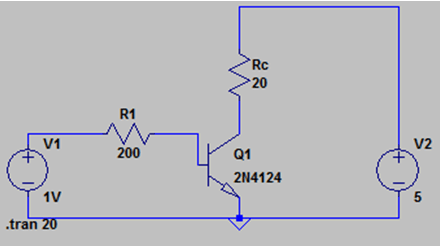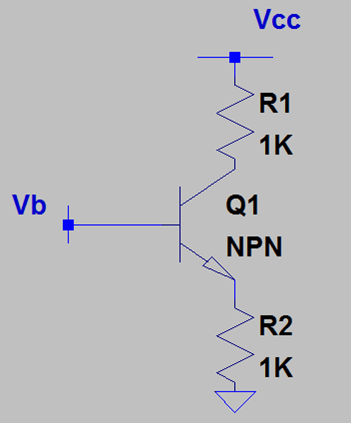This set of Microelectronics Multiple Choice Questions & Answers (MCQs) focuses on “Models of a BJT”.
1. At room temperature, the charge in an electron is found out to be ‘q’. If the temperature is kept unaffected by the climate and a steady humidity is present, what should be the maximum amount of voltage change that follows the small signal model?
a) VT
b) 2 * VT
c) VT/4
d) Room temperature
View Answer
Explanation: VT is the thermal voltage at room temperature. The small signal perturbations or small changes in the signal should be much less than 26mV. So, if the P-P value exceeds 26mV, the small signal model is not used.
2. What is the bias value of the collector current in the following circuit? Choose rπ=800Ω and Is=5*10-16A. Ignore Early effect.

a) 1.15mA
b) 2mA
c) 1.5mA
d) Data incomplete
View Answer
Explanation: The bias value of the collector current is the D.C. value generated from V1.
VBE=V1 * (rπ / R1 + rπ) = .8V and IC = IS * exp(\(\frac {V_{BE}}{V_T}\)) = 1.5mA.
3. Which current is more fundamental to the large signal model?
a) IS
b) IC
c) IE
d) IB
View Answer
Explanation: The collector current is more fundamental to the large signal model since a large change in the collector current implies that the small signal model is forbidden and we have to use the large signal model.
4. Why does the large signal model lead to complex computations for establishing the parameters?
a) Non-linearity
b) Delay due to other factors
c) Amplification
d) Too many parameters
View Answer
Explanation: The large signal model involves a non-linear operation which is defined by the exponential relationship of the I-V characteristics of the diode. The output is a function of the exponential behavior of the input signal and this leads to complex computations.
5. What happens to r0 with an increase in early voltage?
a) It increases
b) It decreases
c) It remains constant
d) It doubles for a decrease in early voltage
View Answer
Explanation: The resistance offered due to early effect increases if the early voltage increases. r0 is directly proportional to the early voltage and hence it would increase.
6. The small signal model of a resistor is a I-V graph of the current flowing through it in response to the voltage given across it’s terminals. If the voltage is V, the current is given by V/R=I from Ohm’s law. If we define αR(t) as co-efficient of change in resistance, and the initial resistance is 10K, find the slope of the model at 77°F.
a) 10-5
b) 10-4
c) 10-6
d) 10-3
View Answer
Explanation: The slope of the graph would be the inverse of resistance at room temperature is nothing but the conductance of the resistor which is very low in this case. It turns out to be 10-4.
7. Suppose there’s a charge distribution defined in the base region. Assuming it to be non-uniform, we know that there is a model which can be used to deal with such charge distribution. What happens to the model if we bring a change in the charge distribution?
a) The Gummel no. changes
b) No such model exists
c) The charge distribution decreases faster
d) Becomes more temperature dependent
View Answer
Explanation: The Gummel-Poon model is used to deal with non-uniform doping in the base. The charge distribution readily affects the Gummel no. which changes the value of current contributed by the carriers in the base or emitter region.
8. How much does the supply voltage influence the bias current?
a) Depends on the bias current
b) A separate bias voltage is used
c) Depends on the topology
d) Does not influence the bias current
View Answer
Explanation: In certain biasing methods, we can use the supply voltage to establish the bias voltage across the B-E junction. In a voltage-divider bias, the supply voltage does influence the bias current while a circuit can also have the bias voltage placed separately. It truly depends on the biasing topology.
9. The transistor is often seen as a voltage-controlled-current source. In which way, does the transconductance vary with the base-emitter voltage?
a) Exponentially
b) Like a ramp function
c) Like a parabola
d) Like a ellipse
View Answer
Explanation: The collector current is exponentially dependent on the base-emitter voltage. This relationship leads to an exponential variation of transconductance with the base emitter voltage.
10. The large signal model of a B.J.T. contains a diode connected between the base and the emitter. Identify which current flows through the diode.
a) (The base current) * (current gain)
b) The bias collector current
c) (The bias collector current) * (current gain)
d) (The bias collector current) / (current gain)
View Answer
Explanation: The base current is simply the bias collector current divided by the current gain. This is the bias base current flowing into the device turning it on.
11. The bias current increases if the emitter can hold a large number of carriers. Since that would lead to a higher diffusion gradient at the beginning of the base region. If the emitter area remains the same but the base width is reduced 10 times, find the change in emitter area to make the current double as before. Assume every other parameter is constant and the early voltage is 0.
a) 20
b) 30
c) .2
d) .3
View Answer
Explanation: If the width of the base reduces by a factor of 10, the total reverse saturation current increases by a factor of 10. To only double the total bias current, we have to reduce the area of the emitter by a factor of 5 and this would lead to a change in the area by 20% or .2.
12. What happens to the current gain if the temperature increases?
a) It increases
b) It decreases
c) It remains constant
d) It first increases and then decreases
View Answer
Explanation: The current gain always increases with temperature. If the collector current is very high, the current gain would decrease.
13. If Vb=2V, VCC=10V, VBE(Active)=0.7V and the common base current gain is .9, find the VCE. Assume that the early effect is neglected and the circuit is at room temperature.

a) 8.21V
b) 5.46V
c) 7.13V
d) 7.53V
View Answer
Explanation: The emitter voltage is 1.3V and the emitter current becomes 1.3mA. The common base current gain leads to a collector current of 1.17mA. Thus the collector voltage is 10-(1.17)=8.83 V. Thus, VCE is 7.53V
Sanfoundry Global Education & Learning Series – Microelectronics.
To practice all areas of Microelectronics, here is complete set of 1000+ Multiple Choice Questions and Answers.
If you find a mistake in question / option / answer, kindly take a screenshot and email to [email protected]
